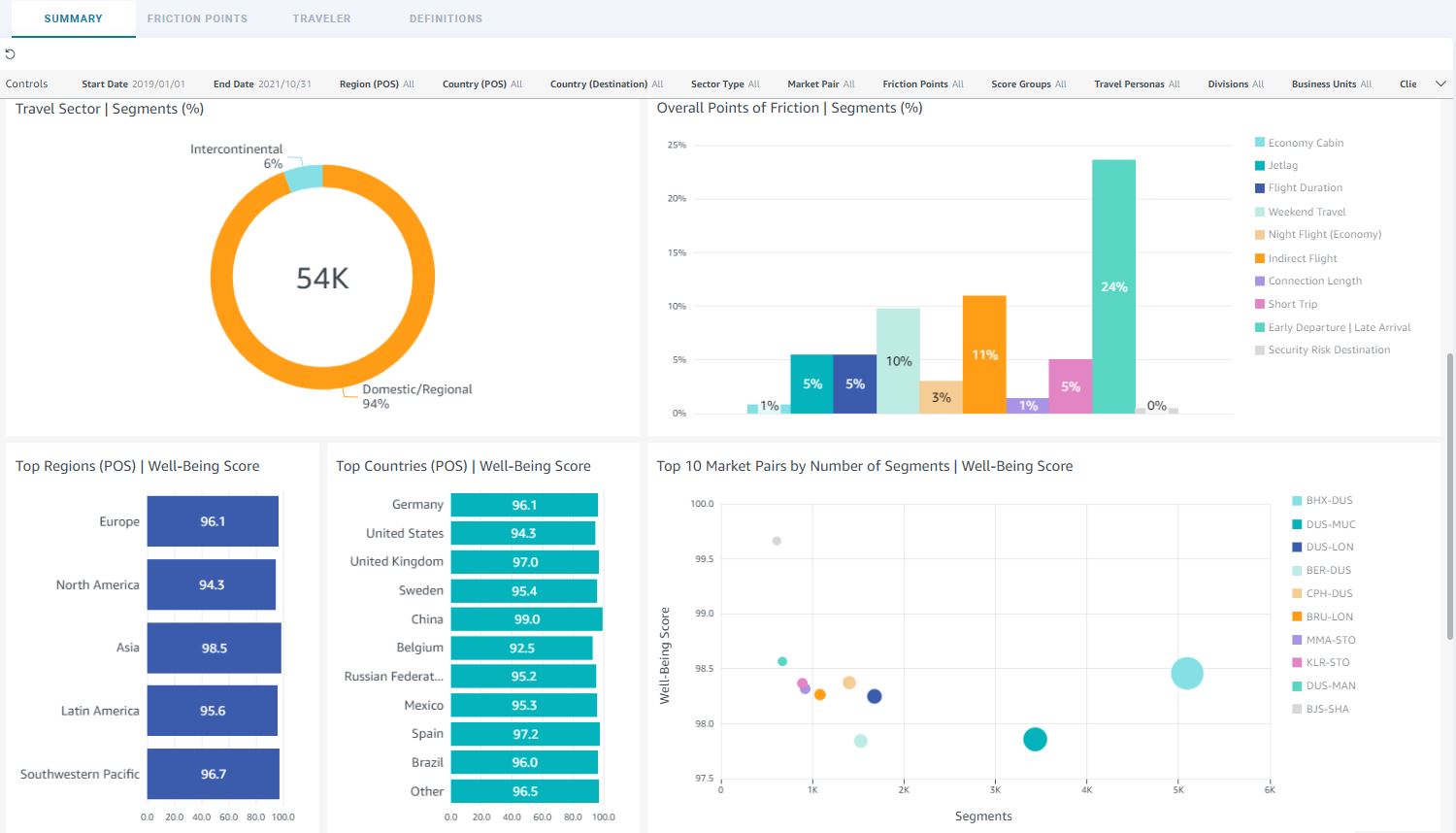
By Julien Etchanchu, Senior Director, Sustainable Collaboration
When building a sustainable travel program, carbon emissions is usually the key component that most companies target. However, emissions reduction should not come at your travelers’ expense.
In order to create a successful strategy, it’s important to take a holistic approach to sustainability and consider key pain points beyond emissions, like traveler wellbeing.
To help our clients effectively measure this component of a travel program, we’ve created a dashboard that specifically evaluates traveler wellbeing across a program. This intuitive, easy-to-access tool works on a trip level, assigning wellness scores based on 10 different factors. This allows travel managers to have an at-a-glance assessment of where they’re doing well and where there are still challenges to address.
How the Traveler Wellbeing Dashboard works
Within the dashboard, each trip starts with a maximum allowance of 100 points. Points are then deducted for every friction point on a trip. For example, weekend travel, connecting flights and crossing multiple time zones all result in lost points.
A few of the key metrics we use to evaluate traveler wellbeing and comfort include:
- Cabin class: Here, we look at whether the traveler is flying economy or premium economy on an intercontinental flight. Although premium economy seats generate more carbon emissions, they clearly provide a less stressful experience for travelers.
- Jetlag: Points are deducted depending on the number of time zones crossed because this has an impact on how comfortable travelers feel. Adjusting to a time difference, especially on shorter trips, can be taxing both during and after the trip.
- Indirect flight: Not only do connections add stress when traveling, but they often significantly increase travel time. While choosing a flight with a connection may have cost benefits, it will typically result in higher emissions and negatively affect the travel experience.
- Early departure/late arrival: Just like with jetlag, encouraging travel early in the morning or late at night can negatively impact a traveler’s wellbeing, productivity, and health.
- Security risk destination: High risk destinations have a potential impact on mental and physical health, and may cause stress. It’s important to understand how traveling to these locations, especially frequently, can take a toll on employees.

Beyond the metrics
The Traveler Wellbeing Dashboard also allows travel managers to track overall travel program metrics. For example, it notes the number of travelers and trips taken, and gives scores for overall wellbeing, domestic/regional wellbeing, and international wellbeing, allowing for easy identification of any differences. It also includes anonymized benchmark data for domestic/regional and international wellbeing, allowing travel managers to see how their company stacks up against other Advito clients, and identify where they are on target, or still have an issue that needs attention.
There are many other ways to look at the data. We help travel managers break it down by segment, points of friction, point of sale, personas, entity, and many other configurations. These help turn the data into insights that are actionable by travel managers and companies wanting to improve traveler wellbeing. For example, the dashboard makes it easy to see if road warriors are having a different experience from occasional travelers, allowing travel managers to adjust their policy accordingly.
Using traveler wellbeing for recommended actions
While the dashboard is directly accessible to clients, Advito also provides recommendations based on the data to flag issues that may need attention. For example, one of our clients in China realized that a number of entities had meetings on Monday mornings, which meant that their travelers had to travel on weekends to get to meetings on time. With the traveler wellbeing dashboard at their fingertips, they were able to adjust many of the meeting times to significantly cut down on weekend travel.
Balancing sustainability priorities
Sometimes there is a tradeoff between traveler comfort and emissions reduction. For example, if a travel policy allows travelers to fly business class, that will result in increased carbon emissions because of the additional cabin space. At the same time, flying business class ensures that travelers are more comfortable, and this is an important consideration, too. Travelers who are unhappy and uncomfortable are unlikely to follow policy recommendations, which could lead to increased carbon emission in the long run.
At Advito, we believe wellbeing and emissions are important. While traveling less is one of our four sustainability pillars, we also recommend that when travelers DO travel, they have a certain degree of comfort. It’s important not to make all of our decisions based on the environment at the employees’ expense. In the end, it comes down to finding the right balance.
Contact us to see how you can leverage the Traveler Wellbeing Dashboard to improve your traveler experience today.
